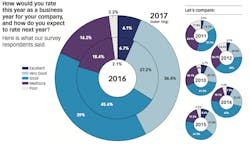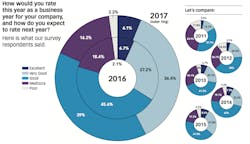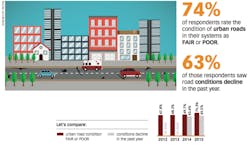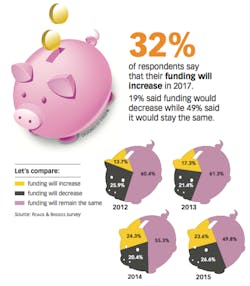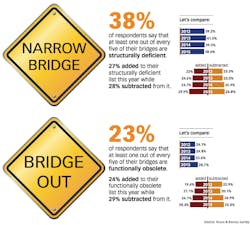State of the Industry: Called for holding
The money in the constant stream is all getting stuck on one big rock. The lever that was created in late 2015 is sitting idle.
Lawmakers in Washington engineered the first long-term highway bill (FAST Act) in more than a decade in December 2015, and when President Barack Obama signed the $305 billion measure into law, many at the state and local level thought it would create market stability—a constant stream of money. However, at press time Congress had yet to pass the highway appropriations bill for 2017, and nobody knows if the annual funding will be the same, more or even less over the next 12 months. So, almost on cue, there is doubt swelling within departments of transportation (DOTs).
“We have the expected amounts, which is great,” Sondra Rosenberg, assistant director of planning for the Nevada Department of Transportation, told Roads & Bridges, “but until Congress actually acts and appropriates that money, we are not 100% sure if that is what we are going to get. It’s very difficult to plan out our resources and that balance between maintaining our assets and expanding.”
Roads & Bridges readers are banking on the fact that Washington will come through on its promise. More than 36% of those responding to the annual Roads & Bridges State of the Industry survey believe 2017 will be a very good year, and an additional 39% say it will at least be a good year. That would mark an uptick from 2016. Just over 27% rate this year a very good one while 45.6% view it as good. When asked if funding was going to increase, decrease or stay the same over the next 12 months, almost 50% believe it will be flat while 31.6% predict an increase in dollars. Only 19.4% see a cut looming.
The need for highway/bridge work is still great. According to a TRIP study just released in November, titled Bumpy Roads Ahead: America’s Roughest Rides and Strategies to make our Roads Smoother, nearly one-third of the nation’s major urban roads (interstates, freeways and other arterial routes) have pavements that are in substandard condition. Roads & Bridges readers would agree, as more than 62% reported a decline in urban pavement conditions and over 50% rated their rural roads in merely fair condition, with another 19% marking them as flat-out poor. Even though a target has been placed on all deficient bridges over the past couple of years, most state DOTs have failed to gain any ground. Just under 45% of R&B survey respondents said the number of structurally deficient bridges has stayed the same over the past year and 46.9% reported no progress when it came to functionally obsolete bridges.
Initially, the market responded positively to the passage of the FAST Act. Many states started spending federal dollars, and on the contractor side 2016 is proving to be a better year than 2015.
“It started to pick up during the summertime, and the bid lettings going into the fall and winter have been better than what they were a year ago,” Brian Deery, senior director, Highway and Transportation, for the Associated General Contractors of America, told Roads & Bridges.
Deery believes 2017 will be just as good as it was in 2016 for contractors, perhaps even a little better.
“In addition to the federal funding, there was a tremendous amount of state initiatives over the last couple of years that are starting to kick in, which I think will help the market as well,” added Deery.
But with success comes competition. When the recession hit, many fled the road and bridge market, but some of them are now back to sniff out the business. The increased competition is thinning out margins, while material prices (minus asphalt) continue to increase to meet the demand.
One high, one low
The state of Indiana remains committed to funding its road and bridge network, no matter who is in charge. Under Gov. Mike Pence the state legislature recently passed a $2.5 billion spending bill for roads and bridges. Now that Pence will be joining Donald Trump in the White House, new Gov. Eric Holcomb has said he will continue the commitment to infrastructure.
The state’s Major Moves program is coming to an end in 2016, but a piece of it will remain alive for some time to come. The program generated $2.6 billion for road and bridge improvements following the lease of the Indiana Toll Road, and also created the Next Generation Trust Fund, which will contribute $500 million every five years to the Indiana DOT.
Big signature projects—I-69, Hoosier Heartland and U.S. 31—were fed by the Major Moves effort, but over the last few years the goal has been to keep the existing infrastructure in good condition.
“We are still firmly in the middle of the echo boom of the interstate system, and that is something we are keeping an eye on and that is part of the reason why the legislature and the governor’s office are so engaged in this topic,” Will Wingfield, spokesman for the Indiana DOT, told Roads & Bridges.
FAST Act money will certainly help the effort. Indiana expects to receive $329 million for state roads and $104 million for local roads during the life of the bill.
Indiana also is one of the few states that have been able to work down its deficient bridges list. To date 96% are in fair, good or excellent condition, with only 4% marked as poor—a 3% improvement since 2012.
Out west, the state of Nevada is experiencing an echo of flat funding. The level, which stands at $800 million in 2016, has not changed much over the last few years as Nevada tries to recover from the recession. The focus has been solely on economic development, like landing the Tesla Gigafactory in Sparks, but the investment level for road and bridge work has yet to improve.
“I don’t think I would call it healthy,” said NDOT’s Rosenberg. “[But] I wouldn’t say we are in dire straits yet. I would say it is uncertain.”
Nevada relies on a state gas tax to fill the transportation coffers, and that tax has not been increased since the early 1990s. The state legislature allowed voters in November to decide if their county could index the gas tax, and those in Clark County were the only ones to approve the move. Washoe County was grandfathered in. The state’s FAST Act allocation is $359 million.
A few years ago the Nevada DOT engaged in preventive maintenance with its road network, but flat funding levels are starting to take their toll, and the overall condition is starting to decline. Bridges are holding up, but according to Rosenberg, “in a couple of years we are going to hit a place where a lot of them are going to be in need of repair all at the same time.” One of the state’s longest bridges, the Las Vegas Viaduct, is almost at that point.
Increasing the rate of deterioration is the rapid population growth, and the Nevada DOT has become much more strategic when it comes to adding capacity. It also is starting to reach out to local agencies to see if funding partnerships could be formed for road and bridge projects.
Trumped
Before Donald Trump’s stunning presidential victory, the father-made millionaire threw out a stunning number for infrastructure investment—$1 trillion.
Trump repeated the need for road and bridge investment in his victory speech, but the details are far from becoming clear. The big question is how to generate $1 trillion. Some say it will come from corporate tax reform, but there also is talk about tax credit bonds, which would work a lot like Build America Bonds.
Regulations which were heavy under Obama might soften under Trump. According to Deery, a lot of the President’s Executive Orders (OSHA regulations, local hiring requirements) were directed at contractors.
On Election Day, voters approved 33 of 48 local and statewide transportation measures, including:
- A $100 million bond issue in Maine;
- A record-breaking $720 million bond proposal for local road, trail and transit improvements in Austin, Texas;
- A sales tax increase to raise $2.1 billion for transit, road and greenspace projects in Charleston and Dorchester counties in South Carolina; and
- Constitutional amendments in Illinois and New Jersey that will protect the states’ highway trust fund.
